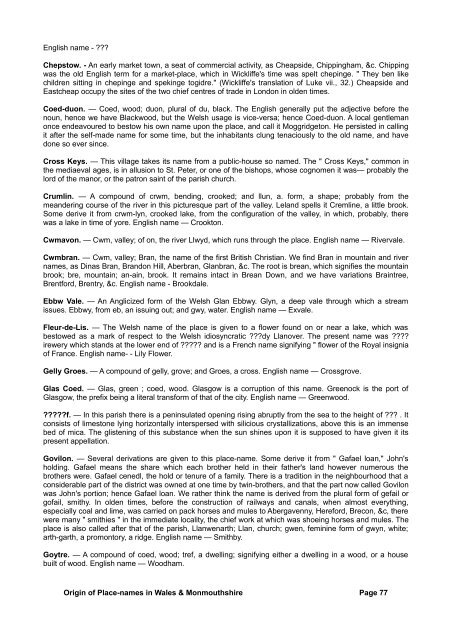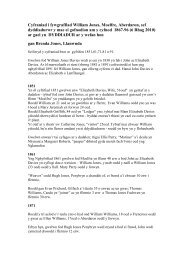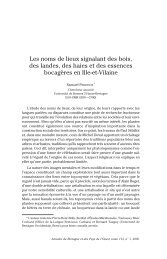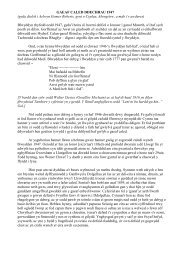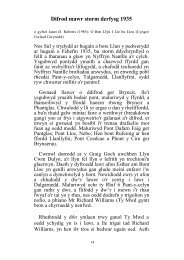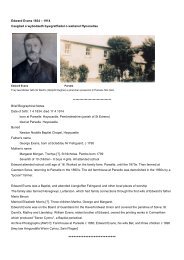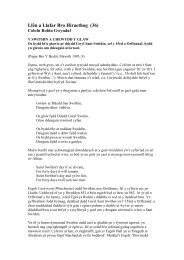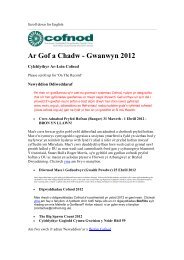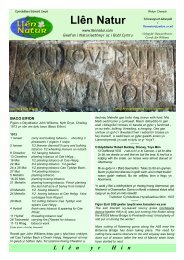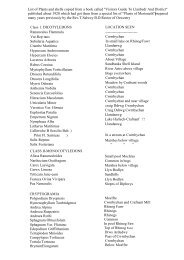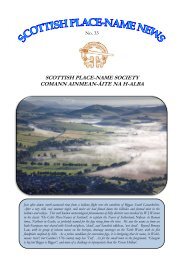English name - ???Chepstow. - An early market town, a seat <strong>of</strong> commercial activity, as Cheapside, Chipp<strong>in</strong>gham, &c. Chipp<strong>in</strong>gwas <strong>the</strong> old English term for a market-<strong>place</strong>, which <strong>in</strong> Wickliffe's time was spelt chep<strong>in</strong>ge. " They ben likechildren sitt<strong>in</strong>g <strong>in</strong> chep<strong>in</strong>ge <strong>and</strong> spek<strong>in</strong>ge togidre." (Wickliffe's translation <strong>of</strong> Luke vii., 32.) Cheapside <strong>and</strong>Eastcheap occupy <strong>the</strong> sites <strong>of</strong> <strong>the</strong> two chief centres <strong>of</strong> trade <strong>in</strong> London <strong>in</strong> olden times.Coed-duon. — Coed, wood; duon, plural <strong>of</strong> du, black. The English generally put <strong>the</strong> adjective before <strong>the</strong>noun, hence we have Blackwood, but <strong>the</strong> Welsh usage is vice-versa; hence Coed-duon. A local gentlemanonce endeavoured to bestow his own name upon <strong>the</strong> <strong>place</strong>, <strong>and</strong> call it Moggridgeton. He persisted <strong>in</strong> call<strong>in</strong>git after <strong>the</strong> self-made name for some time, but <strong>the</strong> <strong>in</strong>habitants clung tenaciously to <strong>the</strong> old name, <strong>and</strong> havedone so ever s<strong>in</strong>ce.Cross Keys. — This village takes its name from a public-house so named. The " Cross Keys," common <strong>in</strong><strong>the</strong> mediaeval ages, is <strong>in</strong> allusion to St. Peter, or one <strong>of</strong> <strong>the</strong> bishops, whose cognomen it was— probably <strong>the</strong>lord <strong>of</strong> <strong>the</strong> manor, or <strong>the</strong> patron sa<strong>in</strong>t <strong>of</strong> <strong>the</strong> parish church.Cruml<strong>in</strong>. — A compound <strong>of</strong> crwm, bend<strong>in</strong>g, crooked; <strong>and</strong> llun, a. form, a shape; probably from <strong>the</strong>me<strong>and</strong>er<strong>in</strong>g course <strong>of</strong> <strong>the</strong> river <strong>in</strong> this picturesque part <strong>of</strong> <strong>the</strong> valley. Lel<strong>and</strong> spells it Creml<strong>in</strong>e, a little brook.Some derive it from crwm-lyn, crooked lake, from <strong>the</strong> configuration <strong>of</strong> <strong>the</strong> valley, <strong>in</strong> which, probably, <strong>the</strong>rewas a lake <strong>in</strong> time <strong>of</strong> yore. English name — Crookton.Cwmavon. — Cwm, valley; <strong>of</strong> on, <strong>the</strong> river Llwyd, which runs through <strong>the</strong> <strong>place</strong>. English name — Rivervale.Cwmbran. — Cwm, valley; Bran, <strong>the</strong> name <strong>of</strong> <strong>the</strong> first British Christian. We f<strong>in</strong>d Bran <strong>in</strong> mounta<strong>in</strong> <strong>and</strong> river<strong>names</strong>, as D<strong>in</strong>as Bran, Br<strong>and</strong>on Hill, Aberbran, Glanbran, &c. The root is brean, which signifies <strong>the</strong> mounta<strong>in</strong>brook; bre, mounta<strong>in</strong>; an-a<strong>in</strong>, brook. It rema<strong>in</strong>s <strong>in</strong>tact <strong>in</strong> Brean Down, <strong>and</strong> we have variations Bra<strong>in</strong>tree,Brentford, Brentry, &c. English name - Brookdale.Ebbw Vale. — An Anglicized form <strong>of</strong> <strong>the</strong> Welsh Glan Ebbwy. Glyn, a deep vale through which a streamissues. Ebbwy, from eb, an issu<strong>in</strong>g out; <strong>and</strong> gwy, water. English name — Exvale.Fleur-de-Lis. — The Welsh name <strong>of</strong> <strong>the</strong> <strong>place</strong> is given to a flower found on or near a lake, which wasbestowed as a mark <strong>of</strong> respect to <strong>the</strong> Welsh idiosyncratic ???dy Llanover. The present name was ????irewery which st<strong>and</strong>s at <strong>the</strong> lower end <strong>of</strong> ????? <strong>and</strong> is a French name signify<strong>in</strong>g " flower <strong>of</strong> <strong>the</strong> Royal <strong>in</strong>signia<strong>of</strong> France. English name- - Lily Flower.Gelly Groes. — A compound <strong>of</strong> gelly, grove; <strong>and</strong> Groes, a cross. English name — Crossgrove.Glas Coed. — Glas, green ; coed, wood. Glasgow is a corruption <strong>of</strong> this name. Greenock is <strong>the</strong> port <strong>of</strong>Glasgow, <strong>the</strong> prefix be<strong>in</strong>g a literal transform <strong>of</strong> that <strong>of</strong> <strong>the</strong> city. English name — Greenwood.?????f. — In this parish <strong>the</strong>re is a pen<strong>in</strong>sulated open<strong>in</strong>g ris<strong>in</strong>g abruptly from <strong>the</strong> sea to <strong>the</strong> height <strong>of</strong> ??? . Itconsists <strong>of</strong> limestone ly<strong>in</strong>g horizontally <strong>in</strong>terspersed with silicious crystallizations, above this is an immensebed <strong>of</strong> mica. The glisten<strong>in</strong>g <strong>of</strong> this substance when <strong>the</strong> sun sh<strong>in</strong>es upon it is supposed to have given it itspresent appellation.Govilon. — Several derivations are given to this <strong>place</strong>-name. Some derive it from " Gafael loan," John'shold<strong>in</strong>g. Gafael means <strong>the</strong> share which each bro<strong>the</strong>r held <strong>in</strong> <strong>the</strong>ir fa<strong>the</strong>r's l<strong>and</strong> however numerous <strong>the</strong>bro<strong>the</strong>rs were. Gafael cenedl, <strong>the</strong> hold or tenure <strong>of</strong> a family. There is a tradition <strong>in</strong> <strong>the</strong> neighbourhood that aconsiderable part <strong>of</strong> <strong>the</strong> district was owned at one time by tw<strong>in</strong>-bro<strong>the</strong>rs, <strong>and</strong> that <strong>the</strong> part now called Govilonwas John's portion; hence Gafael loan. We ra<strong>the</strong>r th<strong>in</strong>k <strong>the</strong> name is derived from <strong>the</strong> plural form <strong>of</strong> gefail org<strong>of</strong>ail, smithy. In olden times, before <strong>the</strong> construction <strong>of</strong> railways <strong>and</strong> canals, when almost everyth<strong>in</strong>g,especially coal <strong>and</strong> lime, was carried on pack horses <strong>and</strong> mules to Abergavenny, Hereford, Brecon, &c, <strong>the</strong>rewere many " smithies " <strong>in</strong> <strong>the</strong> immediate locality, <strong>the</strong> chief work at which was shoe<strong>in</strong>g horses <strong>and</strong> mules. The<strong>place</strong> is also called after that <strong>of</strong> <strong>the</strong> parish, Llanwenarth; Llan, church; gwen, fem<strong>in</strong><strong>in</strong>e form <strong>of</strong> gwyn, white;arth-garth, a promontory, a ridge. English name — Smithby.Goytre. — A compound <strong>of</strong> coed, wood; tref, a dwell<strong>in</strong>g; signify<strong>in</strong>g ei<strong>the</strong>r a dwell<strong>in</strong>g <strong>in</strong> a wood, or a housebuilt <strong>of</strong> wood. English name — Woodham.Orig<strong>in</strong> <strong>of</strong> Place-<strong>names</strong> <strong>in</strong> Wales & Monmouthshire Page 77
Griffithstown. — This village was named after a Mr. Griffiths, who now resides <strong>in</strong> <strong>the</strong> <strong>place</strong>.Grosmont. — This name signifies a mount marked by a cross. English name — Crossmount.Henllys. — Hen, old, ancient; llys, a court, a hall, a palace. Various courts (llysoedd) were held <strong>in</strong> oldentimes called Llys y bren<strong>in</strong>, <strong>the</strong> k<strong>in</strong>g's court; llys benadur, <strong>the</strong> pr<strong>in</strong>cipal court; llys breyr, a court baron; henllys,old court. English name — Oldcourt.Kemeys. — A gross mutilation <strong>of</strong> Cemaes, which is a compound <strong>of</strong> cefn, ridge, high; <strong>and</strong> maes, a field;signify<strong>in</strong>g a high <strong>place</strong> form<strong>in</strong>g a vantage ground for military operations. English name — Highfield.Llanarth. — A compound <strong>of</strong> llan, church; <strong>and</strong> garth, a promontory, a ridge; signify<strong>in</strong>g a church built on a high<strong>place</strong>. English name — Hillchurch.Llanbadoc. — A corruption <strong>of</strong> Llanfadog, from <strong>the</strong> dedication <strong>of</strong> <strong>the</strong> church to St. Madog. Madog is derivedfrom mad, a good, a benefit. Madog, goodly. English name — Goodchurch.Ll<strong>and</strong>egfeth. — From <strong>the</strong> church be<strong>in</strong>g dedicated to St. Tegwedd. Tegwedd signifies one <strong>of</strong> a nobleappearance. English name -- Nobleton.Ll<strong>and</strong>ogo. — Dogo is a corruption <strong>of</strong> Odoceus, <strong>the</strong> name <strong>of</strong> <strong>the</strong> sa<strong>in</strong>t to whom <strong>the</strong> church is dedicated.English name — Odoceus.Ll<strong>and</strong>dewi Rhydderch. — The church was built or founded by Rhydderch, Richard, one <strong>of</strong> <strong>the</strong> threegenerous pr<strong>in</strong>ces <strong>of</strong> Brita<strong>in</strong>, <strong>and</strong> dedicated to St. David. English name — Richardston.Llanellen. — From <strong>the</strong> church be<strong>in</strong>g dedicated to St. Ellen. English name — Ellenston.Llanfaches. — From Maches, a sa<strong>in</strong>t <strong>of</strong> <strong>the</strong> sixth century, <strong>and</strong> a daughter <strong>of</strong> Gwynlliw Filwr, who sufferedmartyrdom here at <strong>the</strong> h<strong>and</strong>s <strong>of</strong> <strong>the</strong> Saxons. Mach means a bail, a surety. English name — Bailton.Llanfair Discoed. — The church is dedicated to St. Mary, <strong>and</strong> is situated at is-y-coed, below <strong>the</strong> wood;hence <strong>the</strong> name. Dis, as a prefix, sometimes implies privation or negation, <strong>and</strong> is equivalent to <strong>the</strong> English im<strong>and</strong> un; so if discoed be <strong>the</strong> right word<strong>in</strong>g, <strong>the</strong> name signifies <strong>the</strong> church <strong>of</strong> St. Mary <strong>in</strong> a woodless <strong>place</strong>.English name — Maryston.Llanfapley. — The name signifies a church dedicated to Fabiali, son <strong>of</strong> Brychan Bryche<strong>in</strong>iog. English name— Fabialton.Llanfethr<strong>in</strong>. — A corruption <strong>of</strong> Llan-Gwy<strong>the</strong>r<strong>in</strong>, <strong>the</strong> church be<strong>in</strong>g dedicated to St. Gwy<strong>the</strong>r<strong>in</strong>. Gwy<strong>the</strong>r<strong>in</strong>means golden ve<strong>in</strong>, or <strong>the</strong> bright or splendid ve<strong>in</strong>. English name — Brightchurch.Llanfihangel Crucorney. — Llanfihangel, St. Michael's church; crug-craig, rock; corn, horn; <strong>and</strong> gwy, water;<strong>the</strong> name signify<strong>in</strong>g a church' built on an elevated <strong>place</strong> on <strong>the</strong> horn <strong>of</strong> <strong>the</strong> water. The village is situated on<strong>the</strong> river Monnow, overshadowed by <strong>the</strong> mounta<strong>in</strong> Skyrrid Fawr. English name — Cragton.Llanfihangel - near - Usk. — Llanfihangel, St. Michael's church. The <strong>place</strong> is situated about six miles northwestfrom <strong>the</strong> town <strong>of</strong> Usk. The river Usk forms <strong>the</strong> boundary <strong>of</strong> <strong>the</strong> parish on <strong>the</strong> south. English name — St.Michael-near- Usk.Llanfoist. — Foist is probably a corruption <strong>of</strong> Faith, Llanfey, Pembroke, accord<strong>in</strong>g to some, is Llanyffydd,Fanum Fidei, <strong>the</strong> church <strong>of</strong> <strong>the</strong> Faith. It is spelt <strong>in</strong> some ancient documents Llanfaith <strong>and</strong> Llanfeth. IagoEmlyn th<strong>in</strong>ks that <strong>the</strong> Normans translated it <strong>in</strong>to Llanfoi, foi be<strong>in</strong>g French for faith. If so, it may easily havebeen changed <strong>in</strong>to Llanfey, Lamphey, <strong>and</strong> Llanfoist. English name — Faithchurch.Llangattwg-Ll<strong>in</strong>goed. — The church is dedicated St. Cattwg. Ll<strong>in</strong>goed may be a compound <strong>of</strong> Hi, stream;yn, <strong>the</strong>; coed, wood; signify<strong>in</strong>g a stream <strong>in</strong> <strong>the</strong> wood. Or <strong>the</strong> prefix may be lla<strong>in</strong>, a slip or long narrow <strong>place</strong>;lla<strong>in</strong> o dir, a slip <strong>of</strong> l<strong>and</strong>; <strong>the</strong> name, <strong>the</strong>refore, signify<strong>in</strong>g St. Cadoc's church on a narrow field near <strong>the</strong> wood.We adopt <strong>the</strong> former. English name — Stream-wood.Llangwm. — The name signifies a church <strong>in</strong> <strong>the</strong> combe or vale. English name — Churchvale.Orig<strong>in</strong> <strong>of</strong> Place-<strong>names</strong> <strong>in</strong> Wales & Monmouthshire Page 78
- Page 1 and 2:
HANDBOOK OF THE ORIGIN OF PLACE-NAM
- Page 3 and 4:
§ § § § §The Author begs to st
- Page 5 and 6:
pitiful cries of the railway offici
- Page 7 and 8:
Bishop Percy says that "in England,
- Page 9 and 10:
The city of Chester is still popula
- Page 11 and 12:
There's Cumwhitton, Cumwhinton, Cum
- Page 13 and 14:
Llwyn in its primary' sense means a
- Page 15 and 16:
PLACE-NAMES IN WALES.Wales. — The
- Page 17 and 18:
Church are generally dedicated to e
- Page 19 and 20:
think he was a contemporary of St.
- Page 21 and 22:
Rhosbeirio. — Rhos, a moor, a dry
- Page 23 and 24:
of Brecknock," states that this vic
- Page 25 and 26:
Cam cnwir ef Cwmdu,Cwm gwyn yw & n
- Page 27 and 28:
Penderyn. — A corruption probably
- Page 29 and 30: Ardudwy. — Ar, upon or above; tud
- Page 31 and 32: to mark its pre-eminence over the o
- Page 33 and 34: Some think that eirw is a corruptio
- Page 35 and 36: present form — Caerfyrddin.Abergw
- Page 37 and 38: place of refuge; hence the name. En
- Page 39 and 40: Llansawyl. — The church was dedic
- Page 41 and 42: eject. The village took its name fr
- Page 43 and 44: house, and attempted to kill an inf
- Page 45 and 46: Gwydir. — Prima facie one may tak
- Page 47 and 48: Nefyn. — The church was probably
- Page 49 and 50: DENBIGHSHIRE.Anglicized form of Din
- Page 51 and 52: Llangollen. — From Collen, a sain
- Page 53 and 54: hands into their pockets to pay a c
- Page 55 and 56: Cefn. — The name signifies a ridg
- Page 57 and 58: Maesgarmon. — Named in honour of
- Page 59 and 60: Abertridwr. — Tridwr, three water
- Page 61 and 62: it is said, was originally built by
- Page 63 and 64: Cwmllynfell. — Cwm, a narrow vale
- Page 65 and 66: Gwarycaeau. — Gwdr, the nape of t
- Page 67 and 68: means a cultivated region, a vale,
- Page 69 and 70: Penrhiwfer.- Pen, head, top; rhiw,
- Page 71 and 72: Port Talbot. — So called in 1835
- Page 73 and 74: Trealaw. — This appellation was g
- Page 75 and 76: Aberdyfi. — So called from its si
- Page 77 and 78: Llanddwywe. — From Dwywau, a desc
- Page 79: Crickhowell and some in the directi
- Page 83 and 84: and gwy, water. Treiddiod troth tna
- Page 85 and 86: derive Tintern from din, fortified
- Page 87 and 88: Caersws. — It appears that the Ro
- Page 89 and 90: English name — Ervylton.Llanymech
- Page 91 and 92: Angle. — Probably from the angle-
- Page 93 and 94: Gellyswick. — Another hybrid. Gel
- Page 95 and 96: that the two rivers in their flowin
- Page 97 and 98: ecame the bishop of the see, and wa
- Page 99 and 100: earth formerly stood on a summit on
- Page 101 and 102: Pilleth. — A corruption of pwll,
- Page 103 and 104: Howells, Rev. J., Mountain AshHowel
- Page 105 and 106: Williams, D., PenywernWilliams, Rev


